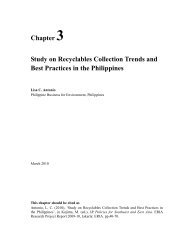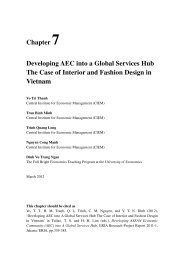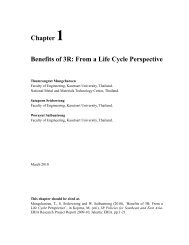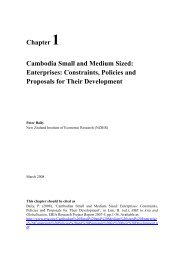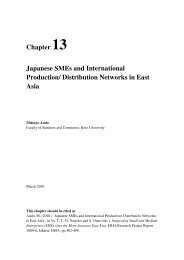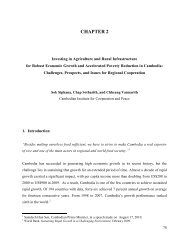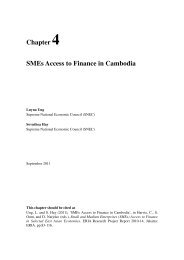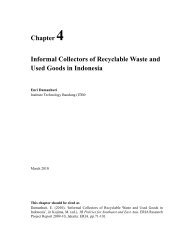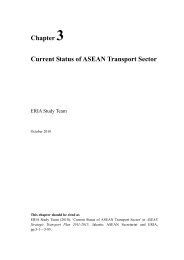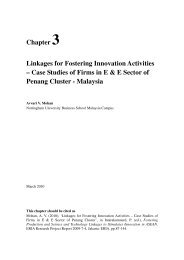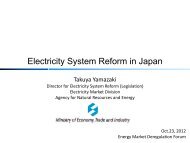Bank Efficiency, Regulation and Response to Crisis of ... - ERIA
Bank Efficiency, Regulation and Response to Crisis of ... - ERIA
Bank Efficiency, Regulation and Response to Crisis of ... - ERIA
You also want an ePaper? Increase the reach of your titles
YUMPU automatically turns print PDFs into web optimized ePapers that Google loves.
4.1. Specific <strong>Bank</strong> CharacteristicIt is interesting <strong>to</strong> note that bank-specific characteristics have an important impact onthe efficiency <strong>of</strong> banks. TE_TA, the capital requirement variable, is positive <strong>and</strong>statistically significant, which indicates that an increase in capital requirements <strong>of</strong> bankstends <strong>to</strong> improve their efficiency. This suggests that banks might experience better riskmanagement if they assume greater ownership <strong>of</strong> their activities. This result is in linewith the recent recommendation by the Basel II Accord <strong>to</strong> increase capital requirements<strong>to</strong> manage the risk-taking activities <strong>of</strong> banks (BIS, 2006). This result is also robust <strong>to</strong>the estimation using a bank efficiency measure which assumes variable returns <strong>to</strong> scale(VRS) as given in Table 2. The estimation based on FE2SLS <strong>and</strong> RE2SLS indicate thatthe impact <strong>of</strong> TE_TA on bank efficiency is much stronger <strong>and</strong> more robust (see Tables 3<strong>and</strong> 4). Our results are also consistent with the recent study on the Brazilian banks byStaub et al. (2009) that indicates that higher bank equity ratio reduces the moral hazards<strong>of</strong> bankers <strong>and</strong> thus reduces the allocative inefficiencies <strong>of</strong> banks.The variables <strong>to</strong> capture the bank liquidity effects are not statistically significant in FE<strong>and</strong> RE estimations as given in Table 1 using the constant returns-<strong>to</strong>-scale measure.However, the non-earning assets <strong>to</strong> <strong>to</strong>tal assets ratio (NEA_A) is statistically significantin Table 2 using variable returns <strong>to</strong> scale. We also notice that the loan loss reserve <strong>to</strong>gross loans ratio (LOANLR_GL) <strong>and</strong> non-earning assets <strong>to</strong> <strong>to</strong>tal assets ratio (NEA_A)variables are statistically significant in FE2SLS <strong>and</strong> RE2SlS estimations as indicated inTables 3 <strong>and</strong> 4. The provisions for more reserves <strong>to</strong> protect loan losses <strong>and</strong> more liquidassets tend <strong>to</strong> improve the overall productive performance <strong>of</strong> banks.The <strong>of</strong>f-balance sheet effect <strong>of</strong> banks (OFFBAL_A) is negative <strong>and</strong> statisticallysignificant at the 1 percent level <strong>to</strong> both the FE <strong>and</strong> RE estimation specifications. It isalso robust <strong>to</strong> the FE2SLS <strong>and</strong> RE2SLS estimations. The negative coefficient <strong>of</strong><strong>of</strong>f-balance sheet activities indicates that constraining the non-traditional activities <strong>of</strong>banks will have a positive outcome on the efficiency <strong>of</strong> banks.Foreign participation <strong>and</strong> ownership in the financial sec<strong>to</strong>r have positive effects onbanking efficiency (see the positive <strong>and</strong> statistically significant coefficient for the303



